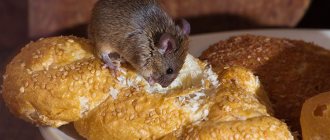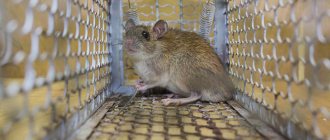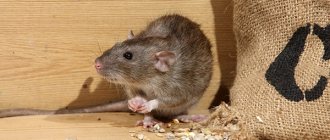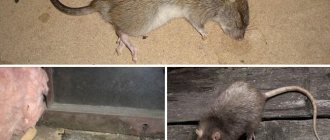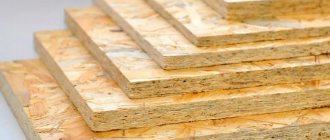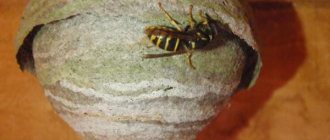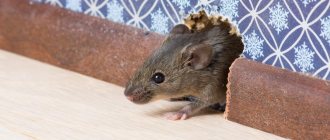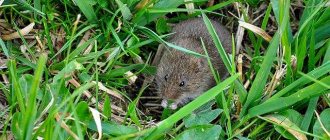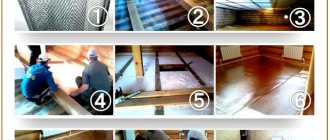What danger do rodents pose to humans?
When settling in houses and apartments, small pests damage furniture, shoes, clothes, and household utensils.
The animals destroy food supplies located in easily accessible places. One individual eats up to 30% of its weight per day, about 2 kg per year. If there are a lot of mice in the house, the damage will be significant. The products and water they have tasted become unfit for consumption. In rooms where mice have infested, an unpleasant odor appears that is difficult to get rid of. Rodents damage finishing (they especially like to chew on insulation) and electrical wiring, causing short circuits that lead to fires. The animals are carriers of dangerous diseases - salmonellosis, leptospirosis, tularemia, hemorrhagic fever, bartonellosis, toxoplasmosis, yersinosis. In addition, rodents are parasitized by fleas and ticks, which can also become a source of infection. The carrier of the disease can be a cat that has eaten a mouse.
Pathogens can be transmitted to humans by:
- direct contact with a living or dead mouse;
- inhalation of particles of dried excrement and wool;
- consumption of foods eaten by rodents;
- contact of animal biological fluids with damaged human skin;
- bite.
Where do mice come from?
These uninvited guests can appear in apartment buildings from the basements, from the side of the garbage chute or trash bin located not far from the building itself. Old ventilation ducts or elevator shafts also facilitate the movement of these animals. If there are cracks in the houses or the building consists of load-bearing walls, ceilings and partitions with hollow internal spaces, then these are the places where such “residents” can still appear in the apartments.
Dampness and warmth are also favorite conditions for such small mammals. That is why these pests so often show their presence in a private home or in heated warehouses closer to winter. In the fall, it is better to check your house or corners in your apartment for holes, cracks or gaps through which animals can easily enter people's homes. Everything should be sealed, plastered with durable plaster and treated with repellent chemicals. In general, they will always look for where it is warmer and where there is food for them.
How rodents get into the house
Can mice and rats get into a house from SIP panels? Of course, they can, just like in a house made of brick, timber, foam concrete and other building materials. First, pests make their way into outbuildings and utility rooms through hatches, basements, ventilation holes or passages along gas and water pipelines. Then they look for convenient approaches to the house and most often get inside through ventilation, sewerage, or cracks and gaps in building structures.
In search of food, rats and mice are able to make holes even in brick and concrete, so the reliability of these materials is very conditional. Therefore, there is no separate problem “rodents and houses made of SIP panels”. There is a common problem - protecting your home from pests.
Myths about mice and vulture panels
House mice are the main type of rodent that lives in the house permanently. They are capable of chewing through any building material without exception. However, supporting those rumors that rodents gnaw and eat only vulture panels is absurd. People smile and say that a mouse will eat a house built using Canadian technology. Only in different parts of the world these houses are successfully equipped and used for housing by many people.
First, you need to check exactly how rodents got inside the house from the vulture panels . Perhaps the place of their entry was communication passages or the attic. So in this way they can get into the house from any material, the only difference is the degree of damage. For example, for a stone structure this is not a problem and it will not collapse.
From everything it follows that during the construction of a building it is necessary to adhere to the rules of sanitary standards and create such conditions so that mice do not consider a house made of this material suitable for existence.
Moreover, in vulture houses there are no passages and protrusions so necessary for the beginning of the life of rodents. Even if the animals get into the panels, they will not be able to find wood with which to start digging.
Rodents and sandwich panels: truth and myths
In everyday life, there is an opinion that field parasites easily penetrate into houses made of SIP panels. This is explained by the fact that the slabs are made from wood, and the insulation is made from a material that is “pliable” for arranging burrows. Moreover, some claim that the building material itself is a delicacy for field animals, and they eat it “for breakfast, lunch and dinner.” So is it true that structurally insulated paneling attracts mice? Do they really feed on sandwich panels and accelerate the destruction of the house itself?
Do you dream of your own home, a holiday home or for permanent residence? There is nothing easier than doing this at TechnoSip.
Look at our catalog of projects, the prices will pleasantly surprise you.
up to 100 sq. m. from 100-200 sq. m. from 200-250 sq. m
Mice have indeed learned to chew various materials, making their way to food and warmth. They easily settle in polystyrene foam, create burrows there, breed and reproduce. Insulation in this regard will suit them quite well. Just don’t forget that this layer is hidden behind two outer OSB boards. This skin is made under pressure, compressed and very durable. In its structure, this plate is similar to glass, which is a material that is “too tough” for rodents, and certainly not the type of food they eat.
Study
The answer to the question about thermal insulators that repel rodents is impossible without market research. In total, it contains two types of heat insulators - organic and artificial.
Organic insulators are made from recycled or natural materials. They contain a minimum of chemical additives - only substances that resist fire. The main examples are ecowool, reed, straw, etc.
There are many more inorganic or artificial heat insulators. And if natural ones are produced, as a rule, in bulk or in slabs, then this category has more formats: slab mineral or basalt wool and loose perlite. You can opt for solid aerated concrete. Next we will talk about reliability indicators in relation to rodents.
Do mice eat polystyrene foam in SIP houses?5.
It's just a myth that mice eat foam. They can make passages in any insulation if they need to get to food in the house, or they want to make a nest in the insulation to raise offspring. Expanded polystyrene in SIP panels is covered on both sides with OSB sheets, which is an additional obstacle in the way of rodents. It’s easier for them to find another way into the house than to chew through the entrance to the OSB.
Proper production of SIP panels
First you need to understand the object of study. A SIP board consists of two sheets of pressed wood shavings and a filler (expanded polystyrene) between them. First of all, it is necessary to distinguish between the questions “Can mice chew the filler” and “Can mice penetrate the SIP panel?” Because if you don’t see the difference between these two factors, you can get confused and draw the wrong conclusion. After all, if we consider the question only in that plane, can mice chew this filler, then the answer will be in favor of mice: they can. But whether they can get to it is a completely different situation, which does not bring anything positive for rodents.
The fact is that the sheets of shavings in which polystyrene foam is tightly and hermetically packed, when exposed to sharp objects, they themselves become sharp and not a single normal mouse will climb into this barbed wire. Even if, as nonsense, we assume that the kamikaze mouse decided to overcome all obstacles and cook up a house for itself in a SIP stove, then this will be the most unprofitable apartment deal in its life, because there will be no air in its future hole. Of course, all this applies only to SIP panels made in compliance with all quality standards, as is customary in our company, and all Internet stories about SIP houses corroded by rubble are most likely either invented by competitors, or posted by unfortunate owners of substandard homes materials purchased from unscrupulous companies that save on everything they shouldn’t. In general, tell me what your home is made of, and I will tell you what will happen to it.
Special design of sip panels
Vulture products consist of two particle boards glued to the insulation with polystyrene foam. The filler is protected on both sides by fire-resistant wood plates, the thickness of which is up to 40 mm. This material is made from solid wood chips pre-impregnated with resin. This material can be compared to crushed glass.
Important: you should only work with such slabs using gloves so as not to injure your skin.
It follows from everything that when mice gnaw on such building material, they perform not only backbreaking work, but also very life-threatening ones.
As for creating a hole in the insulation, this is also nonsense, because mineral wool is more acceptable for mice.
SIP panels and rodents
Outside the city, the problem of rodent control often becomes a hot topic, especially since the number of animals increases every year. After all, there are no barriers for their teeth - drywall, polystyrene foam, wood, and there are also cases of their appearance in brick houses. The only thing they can't overcome is glass, stone and excellent quality concrete.
Myths about mice and vulture panels
House mice are the main type of rodent that lives in the house permanently. They are capable of chewing through any building material without exception. However, supporting those rumors that rodents gnaw and eat only vulture panels is absurd. People smile and say that a mouse will eat a house built using Canadian technology. Only in different parts of the world these houses are successfully equipped and used for housing by many people.
First, you need to check exactly how rodents got inside the house from the vulture panels . Perhaps the place of their entry was communication passages or the attic. So in this way they can get into the house from any material, the only difference is the degree of damage. For example, for a stone structure this is not a problem and it will not collapse.
From everything it follows that during the construction of a building it is necessary to adhere to the rules of sanitary standards and create such conditions so that mice do not consider a house made of this material suitable for existence.
Moreover, in vulture houses there are no passages and protrusions so necessary for the beginning of the life of rodents. Even if the animals get into the panels, they will not be able to find wood with which to start digging.
[ads-pc-1]
Special design of sip panels
Vulture products consist of two particle boards glued to the insulation with polystyrene foam. The filler is protected on both sides by fire-resistant wood plates, the thickness of which is up to 40 mm. This material is made from solid wood chips pre-impregnated with resin. This material can be compared to crushed glass.
Important: you should only work with such slabs using gloves so as not to injure your skin.
It follows from everything that when mice gnaw on such building material, they perform not only backbreaking work, but also very life-threatening ones.
As for creating a hole in the insulation, this is also nonsense, because mineral wool is more acceptable for mice.
How exactly can mice get into the house?
Communication inputs and outputs
A vulture covering for a mouse moving from the ground is an insurmountable obstacle, unless careless workers create favorable conditions for the animal to enter the house, namely poorly insulated openings. And a closed plumbing box at the end of such holes is a perfectly equipped springboard for life.
Drywall frame
A panel house must be sheathed with plasterboard strictly according to the sheet, without using a frame. If a foreman recommends using a frame to make it easier to hide communications, he simply does not want to spend more time.
Important: the frame is additional space for mice to enter the house.
Holes in the structure
All holes in vulture walls and ceilings must be carefully processed and sealed with sealant. It is necessary to pay great attention to the formation of boxes so that they can be accessed in the future, and to make jumpers in advance that will create unfavorable conditions for the movement of living creatures.
Metal mesh with small cells should be built into the base and foundation; they will make it impossible for rodents to penetrate. And install removable plastic nets on windows and doorways, which will also help get rid of insects.
Additional accessories
In addition, to prevent rodents, of which there are many on the site, from getting into a house built using Canadian technology through any roundabout routes, you should use means to catch them:
- Mousetraps are indispensable when the route to housing is cut off;
- Poison pills - if there are no children or animals in the house;
- Crushed glass - poured into a place repeatedly attacked by mice;
- Ultrasonic repellers - according to user reviews, are not always effective;
- Cat - although not all felines love hunting all kinds of living creatures.
Conclusion
When building a house from this material, you should not be afraid of the appearance of living creatures, if you take into account all the recommendations during construction, we simply do not eat the vulture panels themselves, which is confirmed by experiments.
For subsequent comfortable living in the absence of unwanted rodent guests, you should take seriously the sealing of holes for communications, and require workers to fulfill their goals efficiently.
Is OSB board harmful?
In the manufacture of OSB boards, glue based on formaldehyde resins is used. It binds wood chips together. Formaldehyde is a toxic substance. The more molecules of formaldehyde there are in the air, the more dangerous it is to be in the room. The degree of toxicity of OSB boards is determined by the maximum permissible concentration (MAC) of a harmful substance in milligrams per 1 cubic meter of air. This parameter is indicated in the hygiene certificate for the product. The maximum permissible concentration of formaldehyde should not exceed 0.003 mg/m³.
Advice: when purchasing SIP panels, ask the manufacturer for a sanitary certificate for OSB boards. Look at the certificate for the toxicity index of the OSB board. If the numbers are from 70 to 120%, then, according to the sanitary classification, this means that the material is non-toxic.
Is polystyrene foam hazardous to health?
EPS - expanded polystyrene - polymer material. During polymerization, styrene molecules (monomer) are cross-linked into polymer chains. According to GOST 10003-90, according to the degree of impact on the human body, styrene belongs to the third hazard class - moderately hazardous substances. According to sanitary standards of the Russian Federation, polystyrene foam can be used as an insulating building material, because its toxic effect manifests itself only when the MPC is significantly exceeded.
In SIP panels, polystyrene foam is covered on both sides with OSB boards - vapor barriers. They prevent styrene from penetrating into the room. High-quality SIP panels have a sanitary certificate, which confirms the safety of the product.
A house made of SIP panels is protected from mice
It would seem that SIP houses are perfectly adapted for the life of mice. In fact, on the contrary, they lack two important elements: closed passages and small holes from which you can gnaw a hole. Even if the mouse gets inside the SIP panel, it will not be able to move freely in it and will not find a hole with a protruding piece of wood, starting from which it can gnaw out a passage.
Among my old clients there was not a single one who complained about rodents in SIP houses. This does not mean that mice or rats cannot live there. Poorly designed heating, water supply inlets, sewerage, ventilation ducts - all this can become a mouse kingdom, and then additional costs will be required. If you encounter rodents in a SIP house, please write to me.
Projects of houses made of sip panels
Number of projects 223
- 5 rooms
- 2 bathrooms
House Project P-83
- To favorites
- 177² Total area
- 11 x 8m Construction area
from 2,392,000 rub. Construction time individually
- 5 rooms
- 2 bathrooms
House Project P-78
- To favorites
- 127² Total area
- 8 x 8m Construction area
from 1,698,000 rub. Construction period 30 days
- 4 rooms
- 2 bathrooms
House Project P-94
- To favorites
- 160² Total area
- 11 x 9m Construction area
from 2,131,000 rub. Construction time individually
- 4 rooms
- 1 bathroom
House Project P-61
- To favorites
- 75² Total area
- 6 x 8m Construction area
from 1,280,000 rub. Construction period 30 days
- 4 rooms
- 3 bathrooms
Project of a house with a flat roof from 15-185m2
- To favorites
- 185² Total area
from 2,497,500 rub. Construction time individually
- 4 rooms
- 2 bathrooms
House Project Lausanne
- To favorites
- 200² Total area
- 10 x 10m Construction area
from 1,606,000 rub. Construction period 30 days
- 6 rooms
- 2 bathrooms
House project VH “18-15” Filomena
- To favorites
- 156² Total area
from 2,106,000 rub. Construction time individually
- 10 rooms
- 6 bathrooms
House Project P-68
- To favorites
- 318² Total area
- 14 x 17m Construction area
from 5,084,000 rub. Construction period 30 days
- 4 rooms
- 2 bathrooms
House Project Tura-1B
- To favorites
- 116.1² Total area
from 1,803,000 rub. Construction period 55 days
- 4 rooms
- 1 bathroom
Lena-B House Project
- To favorites
- 112.4² Total area
from 1,319,000 rub. Construction period 50 days
- 6 rooms
- 2 bathrooms
Carlsbad House Project
- To favorites
- 200² Total area
- 10 x 10m Construction area
from 3,097,581 rub. Construction time individually
- 5 rooms
- 2 bathrooms
House project VH “18-12” Alienta
- To favorites
- 144² Total area
from 1,944,000 rub. Construction time individually
- 5 rooms
- 3 bathrooms
Irtysh-P-SIP House Project
- To favorites
- 115.4² Total area
from 1,287,000 rub. Construction period 55 days
- 3 rooms
- 2 bathrooms
House Project P-50
- To favorites
- 82² Total area
- 8 x 14m Construction area
from 1,848,000 rub. Construction period 30 days
- 4 rooms
- 2 bathrooms
House Project P-36
- To favorites
- 208² Total area
- 13 x 12m Construction area
from 2,959,000 rub. Construction period 30 days
- 3 rooms
- 3 bathrooms
House Project P-11
- To favorites
- 136² Total area
- 8 x 8m Construction area
from 2,129,500 rub. Construction time individually
Available at the exhibition
- 2 rooms
- 2 bathrooms
Silver House Project
- To favorites
- 108² Total area
from 1,500,000 rub. Construction period 90 days
- 2 rooms
- 1 bathroom
House project VH "67-13" Palermo
- To favorites
- 149² Total area
from 2,011,500 rub. Construction time individually
- 5 rooms
- 1 bathroom
Pechora-5K House Project
- To favorites
- 93.8² Total area
from 685,000 rub. Construction time 33 days
- 6 rooms
- 2 bathrooms
House Project P-84
- To favorites
- 163² Total area
- 10 x 8m Construction area
from 2,216,000 rub. Construction time individually
View all projects
In Soviet times, almost every child had a construction set from which they could make anything.
And now you have a unique opportunity, despite your age and social status, to build your Universe, remaining unnoticed by your wife and children. You do not need to worry about the safety of your Civilization, because no child will be physically able to take away your construction part in the form of a SIP panel. And from a certain point, you will begin to notice that the phrase “Darling, I went to the site” will delight your wife and make you feel tender.
The building materials market is quite extensive and it is clear that building materials such as SIP panels are not so popular, which causes a lot of controversy, even among professionals.
Precautionary measures
Communication inputs and outputs
Traditionally, rodents live in the ground. It is from there that they enter the house.
Drywall on frame
All instructions for finishing SIP houses say that gypsum boards are sewn without a frame directly onto flat walls made of SIP panels. There are many reasons for this. However, every second foreman-finisher “recommends” the owner to make drywall on the frame: “the walls will be smoother, and the wiring will be easier.” In fact, the “worker” is driven by illiteracy and the desire to earn more money.
Among all the disadvantages of frame cladding, there is one more: the appearance of uncontrolled space for rodents to move around. If your walls have already been sheathed on a frame, remove it as soon as possible!
Holes in walls and boxes
All openings in ceilings and between rooms must be foamed and treated with sealant. You need to be careful about all the boxes, have access to them and make jumpers in advance that do not allow any living creatures to move in them. Metal mesh with small mesh helps keep rodents out (in the foundation vents and at the bottom of the basement), and plastic mesh should be used on windows and the roof to keep insects out.
Mice and rats in SIP houses
Throughout human history, rodents have been direct competitors of humans in the struggle for food resources, and with the advent of primitive gathering and food storage, mice and rats became his enemies.
A modern city dweller treats them as funny animals, but in a traditional village no one would think of keeping a mouse in the house. In a country individual house, it is not so difficult to fight rodents, but you should take care of this in advance. If mice or rats have made their way into the food room, it will not be so easy to drive them out.
Under certain conditions, mice can gnaw through many materials: if you need to expand the opening of a hole, wood, drywall, and foam are not a problem for them. There are cases when rodents even gnawed at bricks. Only metal, hard stone, good concrete and glass resist their sharp teeth.
A house made of SIP panels is protected from mice
It would seem that SIP houses are perfectly adapted for the life of mice. In fact, on the contrary, they lack two important elements: closed passages and small holes from which you can gnaw a hole. Even if the mouse gets inside the SIP panel, it will not be able to move freely in it and will not find a hole with a protruding piece of wood, starting from which it can gnaw out a passage.
Among my old clients there was not a single one who complained about rodents in SIP houses. This does not mean that mice or rats cannot live there. Poorly designed heating, water supply inlets, sewerage, ventilation ducts - all this can become a mouse kingdom, and then additional costs will be required. If you encounter rodents in a SIP house, please write to me.
Precautionary measures
Communication inputs and outputs
Traditionally, rodents live in the ground. It is from there that they enter the house.
Fortunately, overcoming the SIP ceiling is an impossible mission for them... unless the owner himself or illiterate workers have made poorly insulated holes for them, through which it is easy to pave the way to food. If such a hole also ends in a closed plumbing box, this is no longer a road, but a fortified bridgehead.
Drywall on frame
All instructions for finishing SIP houses say that gypsum boards are sewn without a frame directly onto flat walls made of SIP panels. There are many reasons for this. However, every second foreman-finisher “recommends” the owner to make drywall on the frame: “the walls will be smoother, and the wiring will be easier.” In fact, the “worker” is driven by illiteracy and the desire to earn more money.
Among all the disadvantages of frame cladding, there is one more: the appearance of uncontrolled space for rodents to move around. If your walls have already been sheathed on a frame, remove it as soon as possible!
Holes in walls and boxes
All openings in ceilings and between rooms must be foamed and treated with sealant. You need to be careful about all the boxes, have access to them and make jumpers in advance that do not allow any living creatures to move in them. Metal mesh with small mesh helps keep rodents out (in the foundation vents and at the bottom of the basement), and plastic mesh should be used on windows and the roof to keep insects out.
Additional funds
If mice and rats have already chosen your area, for example, in a barn or a warm basement, the following means are usually used:
- Mousetraps (they help if you know that the way for rodents to enter the house has already been cut off).
- Poison pills (cruel but effective method - if there are no children or pets in the house).
- Crushed glass - when mice persistently make a hole in the same place.
- Ultrasonic repellers (as people write - not all of them help).
- Cat (not every cat catches mice).
If you are planning to build a house from SIP, you should not be afraid of mice - this problem is rather far-fetched. But you can’t completely relax, especially when wiring communications. Remember that these small animals are the sworn enemies of humans in nature.
Do pests live in SIP panels?
Residents of apartments claim that pests can chew through concrete if they smell the delicacy. Therefore, people are concerned about the question of whether mice chew on vulture panels and whether they can make a hole in the insulation.
On a note!
Builders claim that a house mouse can get into modern homes through a sewer pipe or ventilation. The mammal will not be able to move in the panels themselves.
The insulation contained in the slabs may be attractive to pests, but if there are more accessible shelters nearby, the animals will prefer them. And getting to the insulation is not easy. In a high-quality product, it is securely covered with OSB boards, which in structure resemble glass.
Interesting!
Mice prefer to chew natural materials: wood or paper.
Mice cannot eat OSB boards. It is solid and has no protrusions or crevices. The mammal has nothing to begin with to build a move. If the animal manages to get inside the slab, it will not be able to move there and will not build a mouse tunnel.
Correct construction from SIP panels
It is important to comply not only with the production standards of these innovative building materials, but also with a lot of technological rules when building such a house. A building made of SIP panels is built without cracks and gaps (if professionals are involved in the matter), so a vole will not be able to enter the house itself (unless it knocks on the door). If the frame structure was not built from SIP panels, but using other technologies, cracks and gaps are possible, and most importantly, there are many voids with insulation, where mice can live so well. But even in this case, the problem can be solved with the help of special anti-mouse impregnations, ultrasonic repellers and other means of combating voles. In addition, even at the construction stage, it is possible to include in the project a slab reinforced concrete foundation, cladding with fine-mesh galvanized mesh, special insulation and a casing. But since all this is expensive and complex, it is easier to build frame houses from SIP panels - these have been standing all over the world for many decades, and there has never been a single case of a building collapsing, eaten away by burrows. If the house is built according to all the rules, it is not afraid of mice.
How to keep rodents out of your home
Although mice cannot live in sip panels, they are able to gnaw and make their way through uninsulated openings. Therefore, it is better to entrust the construction of a house to a professional team that will not leave any gaps for pests. If you decide to build yourself, then follow all the recommendations and consult with builders.
An illiterate or unscrupulous worker may advise flashing a house with plasterboard on a frame. But this creates free space between the walls that the owner cannot control.
On a note!
The instructions for the sip panel say that drywall should be sewn onto the wall without a frame.
You cannot leave loopholes for rodents. The slightest cracks in the ceilings must be sealed with sealant. If there are no holes, then the small creature simply will not be able to get into the house.
Why do rodents damage floors and walls of houses?
The gray robbers are forced to chew everything and everywhere by the physiological structure of mice, namely their teeth. The constant growth of the front incisors leads to the need for their constant grinding. Otherwise, the animal will not be able to eat normally and will die of starvation.
Often in the ceilings, as well as in the walls of houses, you can find entire mouse labyrinths. Field and house mice do them in search of food and water. In addition, the animals explore the territory, choosing a secluded place to build a nest.
Houses made of sip panels and mice are no exception and houses made of panels. However, this does not mean that mice chew through the OSB board. Animals can enter the premises through entrance doors, poorly sealed chimneys, ventilation, cable or drain openings. Therefore, such mouse paths should be carefully isolated to prevent rodent control.
However, reviews from residents vary regarding the fact that mice do not breed in vulture panels.
Additional Precautions
If there is a risk of an animal getting into the house or in a room where there is a lot of food that is attractive to mice, then you should think about precautions.
On a note!
Builders claim that mice do not live in vulture panels; reviews from residents of such houses confirm the words of professionals. But rodents can still get into human homes.
The following remedies will help eliminate stray pests:
- place mouse traps-cages and glue-based traps for mice;
- spread out mouse poison or poisonous tablets;
- get a rat-catcher cat;
- turn on the ultrasonic repeller.
If there are small children or pets in the house, then it is better not to use chemicals. Mousetraps and glue traps should be hidden so that you do not get caught in them. The sticky substance does not dry for a long time and is difficult to remove from skin and clothing, and the trap can cause injury.
The answer to the question of whether mice eat vulture panels can only be negative. But a house built from these materials cannot protect one hundred percent from rodents. Therefore, it is worth taking additional protective measures.
Rating( 2 ratings, average 5 out of 5 )
What is a sip panel
You can often hear the statement that there are mice in vulture panels. First you need to find out what this design is:
- A vulture panel is two particle boards separated by a layer of expanded polystyrene;
- The composition of such boards includes a mixture of resin and perpendicularly laid layers of chips.
Sip panels and mice Due to which the OSB board has increased strength (the structure of such panels is comparable to glass). In addition, the slabs are distinguished by sharp-angled, spiky edges, which can easily damage the oral cavity of a rodent.
On a note!
Many manufacturers add a special repellent antiseptic composition to the mixture of shavings and resin, which forces mice to avoid houses made of vulture panels.
Expanded polystyrene is also not of interest to rodents, since it has a dense structure and is completely inedible. Rodents prefer softer fleecy insulation materials. Therefore, the answer to the question of whether mice eat vulture panels can only be negative.
How to deal with mice in walls
With the arrival of autumn, mice migrate from the fields to human homes, where it is warm, dry and there is something to eat. They often make nests for themselves or make passages in the walls, especially if the interior partition is hollow inside. We will try to find out how to get rid of mice in the walls in this article. First of all, it would not hurt to identify the source of trouble and eliminate it. To understand the location of harmful animals, there is a proven method: at night, sprinkle flour on the floor and, based on the tracks left by the animals, determine where they crawl out from, where they roam and where they return. Based on this data, they carry out extermination measures.
The second option also needs to be completed. Carefully check all the walls in the apartment or house to detect holes through which rodents enter the room. These entrances and exits can be either of construction origin (unsealed cracks, holes under baseboards or on the surface left after repairs) or biological, that is, made by household pests.
Prevention of occurrence
When there are first attacks on vegetables, the presence of tunnels and nests for mice, urgent measures must be taken to get rid of them. The sooner you start, the easier it will be to get rid of them. But you can also be prudent about the possible appearance of rodents and take preventive measures. They need to be carried out until mid-autumn, before the cellar is filled with vegetables and preparations. They will prevent rodents from appearing in the basement.
In this video we will look at how to rid a cellar of mice:
This is useful: .
Preventive methods of dealing with future rodents:
- Equip the door with a metal covering. A thin sheet is enough.
- Cover all ventilation openings with fine metal mesh. Don't forget that a small mouse can fit through a hole the diameter of a felt-tip pen.
- Pack all products in airtight containers. Cover them tightly with the lid.
The effectiveness of these methods depends on the quality of the load-bearing walls in the room. If they are brick or concrete, everything will work fine.
Methods of disposal
Elimination measures depend on the ways mice penetrate inside the walls. Follow the following tips.
All discovered holes and burrows must be carefully filled with a mixture of concrete and glass - this composition will be too tough for mice. First, poison, blackroot grass, tansy (or other poisonous plants that rodents are afraid of) or rags soaked in a solution of ammonia, vinegar, mothballs, and peppermint extract are placed in the hole.
Particular attention is paid to utility lines, through which mice can also easily get inside the wall. All ventilation ducts are covered with a fine-grained metal mesh, the outlets of sewer and water pipes are sealed and sealed so that no hole can squeeze through the existing gap.
True, the methods described above, although effective, have their own side effect: the walled up animals will sooner or later die of hunger, and their corpses will begin to emit a rather specific aroma.
Therefore, you should choose a poison with a mummifying effect (for example, mortorate, “rat death, etc.), in this case the flesh does not decompose, but dries out. But before repair work, it is better to lure the mice out of the nest and destroy them using any available method, or even better, in several ways at once.
Various tricks are used for these purposes:
- mechanical traps with bait;
- sticky backings, again with an attractive treat in the center;
- ultrasonic repellers;
- unpleasant odors for rodents;
- anti-mouse herbs (black root, tansy, wild rosemary);
- rat poison;
- They don’t forget about cats, mice don’t like being around them;
- electronic live traps.
It is clear that it is necessary to lay out and install “enticement boxes” not throughout the house, but where the animal gang most often appears: near burrows, next to food supplies. When working, do not forget about their own safety and the safety of their household, especially protect pets and children from traps and poisonous baits, so as not to cause trouble in the form of poisoning or serious injuries.
Ways to control rodents
If during the construction of a frame house measures were not taken to protect against rodents, it is worth taking care to destroy mice in other ways. There are several ways to deal with mice. Choose what suits you best or apply comprehensive protection.
Traditional methods of rodent control
Frame house without rodents: prevention and solution to the problem
• Line the perimeter under the floor with broken glass, lay burnt wood, its smell repels rodents
• Sprinkle red pepper along the outside walls of the house.
• Add substances to the insulation that repel rodents with their smell - wormwood, mint, pine branches, slag, ash
• Soak rags with Vishnevsky ointment and place them in rodent holes or fill them with water. Alternatively, you can throw a firecracker into the hole, but in this case, take care of safety
• Mice don’t like the smell of burning wool, use this knowledge to repel them
• Create noise disturbance by placing tin bottles on the bars or burying glass bottles in the ground.
Biological protection
Frame house without rodents: prevention and solution to the problem
A natural defense against mice is to have a cat. Rodents will leave the room in which the hunter cat lives. Remember that not all cats are capable of catching mice; decorative breeds will look at a mouse with horror or not pay any attention to it. Therefore, take an ordinary yard cat into your home, of course, if you or your household members are not allergic to wool.
Mice will run away just from the smell of the cat's litter box, but in this case, won't you run away from the house along with the rodents?
Traps and mousetraps
Frame house without rodents: prevention and solution to the problem
Traps and mousetraps can be bought at the store. This could be a traditional mousetrap. A mousetrap that does not kill rodents, the simplest models of which cost no more than 50 rubles. Manufacturers of electronic options guarantee one hundred percent absence of mice in the house. The effectiveness of glue traps depends on the price, so the more expensive the better. Remember that if the rodents are not killed but released, there will be no effect. If you are releasing them for humane reasons, then do it as far from home as possible.
Place traps and mousetraps along walls and rodent habitats. Pests usually move along the same route.
You can make a trap yourself.
Trap 1
. Apply anti-rodent glue to a sheet of cardboard or plywood and secure the platform. Place the bait in the center. The mouse, trying to free itself, will stick to the surface even more.
Trap 2
. Pour water into a bucket, pour straw on top, add a spoonful of butter and seeds. Place an improvised ladder in the shape of a stick next to the bucket. The mouse will fall into the water and will not be able to get out. You can improve the design by nailing two planks in a cross, one larger than the diameter of the container, the other slightly smaller. At the end of a small plank, the bait will attract a rodent and it will fall into the water, the structure will return to its place. Thus, several mice fall into the trap.
Trap 3
. Pour unrefined sunflower oil into a glass beer bottle and secure it at an angle of 30 degrees. Pests, once inside, will not be able to get out.
Poisoned baits
Frame house without rodents: prevention and solution to the problem
The industry offers a large number of chemicals for killing rodents. But, be careful if children and pets live in the house. Access to toxic substances must be strictly limited.
If there are small children in the house, it is not recommended to use chemicals. Consider alternative methods of rodent control.
High-quality anti-rodent preparations are sold in the form of briquettes, granules, and grain baits. Before using poisonous baits, read the instructions and follow the directions. The disadvantage of this method is that the mouse may die inside the partition of the house; a terrible smell will penetrate the house after the corpse begins to decompose. Moreover, no “mummifying” types of bait will prevent this. Some baits contain substances that cause suffocation. In this case, the pests will strive to get out into the air as quickly as possible.
Ultrasonic repellers
Frame house without rodents: prevention and solution to the problem
Ultrasonic repellers can be effective in controlling mice. Customer reviews are contradictory. Before buying such a device, study what they say about this or that device. There are ultrasonic generators of both domestic and foreign production on sale. The results of repellers are not immediately noticeable; to protect your home you will need several devices. Among the disadvantages, it is worth noting the frequent replacement of batteries and protection of the device from an aggressive external environment, in particular from rain. Taking drastic measures will allow you not to fight pests every year, but will get rid of rodents forever. Install the mesh, change the insulating material, seal the cracks and crevices. And remember that it is easier to prevent a rodent infestation than to get rid of them later.
How to get rid of rats in the house using poison
One of the main advantages of the so-called rat poisons is the ability to quickly exterminate a large number of rodents with their help. After being laid out in the house, such preparations work completely autonomously, and only as the animals eat the poison, its quantity must be periodically replenished with new portions.
An example of how this usually works in practice: say, if five rats live in a house and they all feast on such a poisonous bait in one night, then they will all die at about the same time. In a week or two, the house will be rid of rodents.
However, it should be borne in mind that not all rat poisons are equally effective - the most effective drugs today contain blood anticoagulants (substances that cause extensive hemorrhages in internal organs and subsequent death in rats) as active ingredients.
Among such substances are flocumafen, brodifacoum, bromadiolone, difenacoum and some others. Of the drugs based on them, the following are quite popular today (with good reason):
- Storm;
- Nutcracker;
- Rat Death #1 and #2;
- Efa;
- Ratindane.
And some others.
These rodent poisons are inexpensive, sold in many stores and really allow you to get rid of rats and mice even in a large private home. The principle of their action is based on the fact that after eating poison, the animal’s blood clotting mechanism is disrupted and, as a result, multiple internal bleeding develops.
Poisons are placed where rodents are likely to find them. Periodically, the presence of poison is checked, and new portions are placed in place of the eaten bait.
Rat poisons can only be used where they cannot be found by pets, children, or anyone other than rats and mice. In particular, it is unacceptable to use such drugs on the street, where birds or stray animals can become poisoned.
The danger to pets who may eat a dying or already dead poisoned rat should also be taken into account.
In order to increase the safety of use, poisons, like traps, can be used in bait stations. However, although domestic animals will not find the actual poison, they may well be able to detect a poisoned rat.
Summary: it makes sense to use poison where there are a lot of rats, and at the same time, it will be possible to find the corpses of animals after death without much effort - in stone houses and basements with strong, good finishing, in rooms where soft insulation is not used in the walls. However, if there is a risk that a cat or dog will find a poisoned rodent, it is better to avoid using poisons.
Ways to control rodents on the ceiling
How to get rid of mice under a suspended ceiling in order to get by with minimal losses, and most importantly, not to spoil the ceiling covering.
You can use mouse poison, which is available in every hardware store. Next, dismantle the lamps on the ceiling and scatter the contents. Just scatter, you cannot use gels, adhesives, etc. compositions, because this will spoil the tension material and visible stains may appear. The problem is that the mouse will not die near the hole; it will take some time before it dies, which means it will die in any area. If the ceiling area is small, then you can use some tricks to get a dead rodent. Well, if the canvas is large, then it will be difficult to remove the body, but it is impossible to leave it. Therefore, before deciding to use poison, it is necessary to consider the consequences of the possibility of disposing of the rodent.
Ultrasonic repellers
Modern technologies make it possible to use ultrasonic repellers to combat rodents. It is worth installing them in problem areas, turning them on for a certain time, and the mice will escape through the holes that came. This will not solve the problem completely, because sooner or later the rodents may return. Work can be carried out on wooden floors after eliminating mice using ultrasound. To do this, above the floors, be it the second floor or the attic, you need to calculate all the holes and seal them.
Traditional methods of controlling rodents in the ceiling
If you don’t want to risk using poison, but there is no ultrasound, then you can use traditional methods of fighting rodents in the ceiling. One of these is installing a mousetrap in the hole under the lamp.
Care must be taken to ensure that the blade is not damaged when installing and closing the mechanism. The second method is a built slide from a hole with bait. A rodent, going down to food, rolls down, where it will be much easier to catch it
You can attach a mousetrap below, then the mouse will not have time to run around in search of salvation
A rodent, going down to food, will roll down, where it will be much easier to catch it. You can attach a mousetrap below, then the mouse will not have time to run around in search of salvation.
Services of specialized teams
To protect yourself from inventing ways to kill mice on the ceiling, you can get the services of specialized teams who will professionally approach the solution to the problem. In addition, the risk of damage to the canvas will be minimized, because independently removing rodents can expose you to making mistakes. As you know, the material that makes up a suspended ceiling is very sensitive to tension. If you unsuccessfully catch the edge in the area where the lamps are attached, the ceiling surface will instantly split along its entire length.
Ways to combat the mouse family
When the mice are already infested, it is necessary to inspect the building and the surrounding area, find the main feeding and movement areas. A visual assessment of occupancy should be made based on existing traces of feces and chewing.
This is what a mouse hole looks like on the property
If there are holes in the local area, they need to be covered with earth or a loose component, and inspected in the morning. Those that will be opened can be considered residential. The regular appearance of animals indicates that the degree of population of this object is high.
Rodenticides - rodent repellents
A group of chemicals of different hazard classes used to kill harmful animals.
The product is selected based on the density of pest infestation. Typically these baits are in the form of granules, powders, foam, tablets and briquettes. The bait contains anticoagulants, which cause internal bleeding, or phosphine, which promotes the release of gas in the stomach. The consumption rate of bait per m2 should be looked at in the instructions.
.
Rodenticides - to kill rodents
Sticky traps and traps
Sticky traps
The advantage of the mechanical method over others is its safety for humans and pets. Therefore, it is widely used in cities and rural areas.
The complexity of arranging fishing gear and the need for systematic observations of them limit the use of the method.
Trap in action
Electronic repellers
There is a rodent control tool that does not cause harm to humans.
In fact, ultrasonic devices create uncomfortable conditions for the mouse family. Ultrasound itself is a means of communication between mice, and any static sounds from the outside will be frightening.
Effect of ultrasound on mice
The fact described below will help you in choosing the right device
Narrow range ultrasound is effective against rats, but less so against mice. Repellers with a variable range are considered more effective.
Sanitation services
Extermination of rodents
How to fight? Deratization is the most effective method of control, allowing you to avoid wasting time and not putting your health at risk. Specialized teams go to the site, examine the location of the mice and carry out measures aimed at exterminating the pests. In this case, certified targeted drugs are used.
